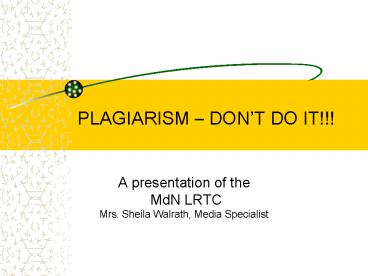PLAGIARISM DONT DO IT - PowerPoint PPT Presentation
1 / 18
Title:
PLAGIARISM DONT DO IT
Description:
If you repeat another's exact words, you MUST use quotation marks and cite the source. ... http://www.madison.tec.wi.us/is/writingcenter/plagarism.htm ... – PowerPoint PPT presentation
Number of Views:67
Avg rating:3.0/5.0
Title: PLAGIARISM DONT DO IT
1
PLAGIARISM DONT DO IT!!!
- A presentation of the MdN LRTCMrs. Sheila
Walrath, Media Specialist
2
Plagiarism What is it?
- List as many examples of plagiarismas you can
think of.
3
Plagiarismwhat is it?
- Based on the examples you brainstormed, what is
your definition of plagiarism?
Heres Websters definition
Plagiarism (After you view the above link, use
the back button of yourbrowser to return to this
presentation.)
4
Plagiarism can also be defined as
- cheating or deception. If you attempt to use
another person's work as if it were your own,
without adequate acknowledgement of the original
source and if this is done in work that you
submit for a grade then you are attempting to
deceive your teacher, your parents, or anyone
reading the paper. In other words, plagiarism is
cheating and it is deceitful in that you are
trying to claim the credit for something that is
not your work.
5
Why is plagiarism wrong?
- If you plagiarize, you are cheating yourself.
You don't learn to write out your thoughts in
your own words, and you don't get specific
feedback geared to your individual needs and
skills. Plagiarism is dishonest because it
misrepresents the work of another as your own. - Unintentional plagiarism is still cheating.
6
Is it really such a big problem?
- According to the website Plagiarism.org
- Recent studies indicate that approximately 30
percent of all students may be plagiarizing on
every written assignment they complete.
7
Catching the plagiarist
- The internet has made plagiarism easier with
access to term paper mills, search engines,
encyclopedias, etc. In response, websites have
been developed which help teachers analyze papers
and develop strategies to prevent plagiarism. - Some sites are
- http//www.turnitin.com/
- http//www.millikin.edu/wcenter/plagiarism3.html
8
Guidelines for avoiding plagiarism
- Use your own words and ideas.
- Give credit for copied, adapted, or paraphrased
material. - Avoid using others' work with minor "cosmetic"
changes. - There are no "freebies."
- Beware of "common knowledge."
9
Guidelines for avoiding plagiarism
- Use your own words and ideas.
- This is a skill that improves with practice.
- It requires an under-
- standing of the topic
- It requires that you give yourself credit for
your own abilities.
10
Guidelines for avoiding plagiarism
- Give credit for copied, adapted, or paraphrased
material. - If you repeat another's exact words, you MUST use
quotation marks and cite the source. - If you adapt a chart or paraphrase a sentence,
you must still cite. - Paraphrase means that you restate the author's
ideas, meaning, and information in your own words - WHEN IN DOUBT, CITE.
11
Guidelines for avoiding plagiarism
- Avoid using others' work with minor "cosmetic"
changes. - Examples using "less" for "fewer," reversing the
order of a sentence, changing terms in a computer
code, or altering a spread sheet layout. If the
work is essentially the same, give credit. - WHEN IN DOUBT, CITE.
12
Guidelines for avoiding plagiarism
- There are no "freebies."
- ALWAYS cite words, information, and ideas you
use if they are new to you (learned in your
research). - No matter where you find it even in an
encyclopedia or on the Internet you cite it. - WHEN IN DOUBT, CITE.
13
Guidelines for avoiding plagiarism
- Beware of "common knowledge."
- You don't have to cite "common knowledge, BUT
the fact must really be commonly known. That
George Washington was the first U.S. president is
common knowledge That George Washington was
an expert dancer is not common knowledge - WHEN IN DOUBT, CITE.
14
How do I cite the sources?
- If you wish to avoid accusations of plagiarism,
you must cite your sources properly. Several
websites exist which can help you. We suggest
that you follow the examples listed in your
schools website.
15
In conclusion, dont get paranoid
- But when you present a work for a grade
- It must be entirely your own work, written by you
in your own words, and containing your own
interpretations, ideas, approaches etc. - It must state clearly where you got other
people's words or major ideas. - It must state clearly where you got your charts,
diagrams, photos, graphics, and media (including
sound, video and digital images.
16
PLAGIARISM DONT DO IT!!!
17
Recommended Resources
- http//www.hamilton.edu/academic/Resource/WC/Avoid
ingPlagiarism.html - http//www.indiana.edu/wts/wts/plagiarism.html
- http//www.virtualsalt.com/antiplag.htm
- http//alexia.lis.uiuc.edu/janicke/plagiary.htm
18
Sources Cited
- Avoiding Plagiarism. Virtual Writing Center. 8
August 2001. lthttp//www.madison.tec.wi.us/is/wri
tingcenter/plagarism.htmgt - Avoiding Plagiarism Mastering the Art of
Scholarship. UCDavis Student Judicial Affairs.
2001. 8 August 2001. lthttp//sja.ucdavis.edu/avoid
.htmgt - Plagiarism.org. 8 August 2001. ltwww.plagiarism.org
gt































